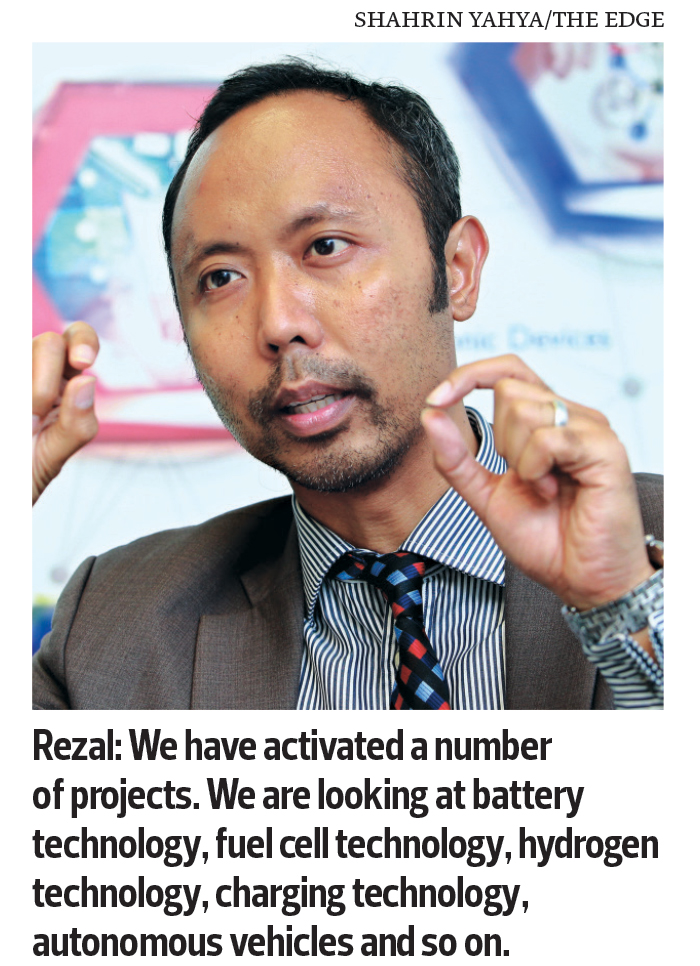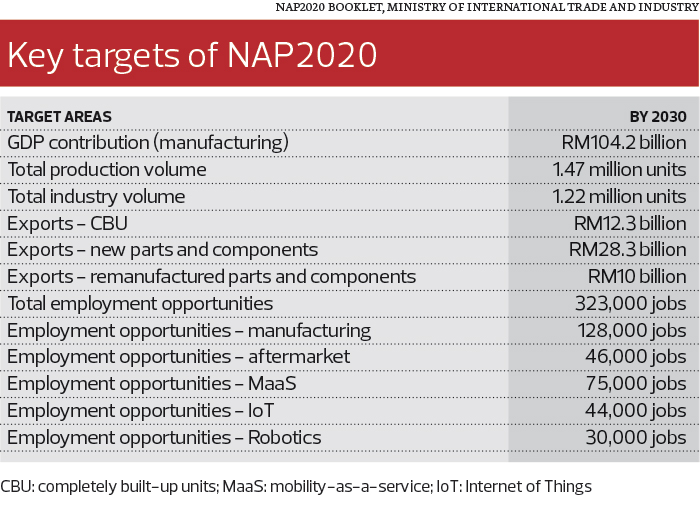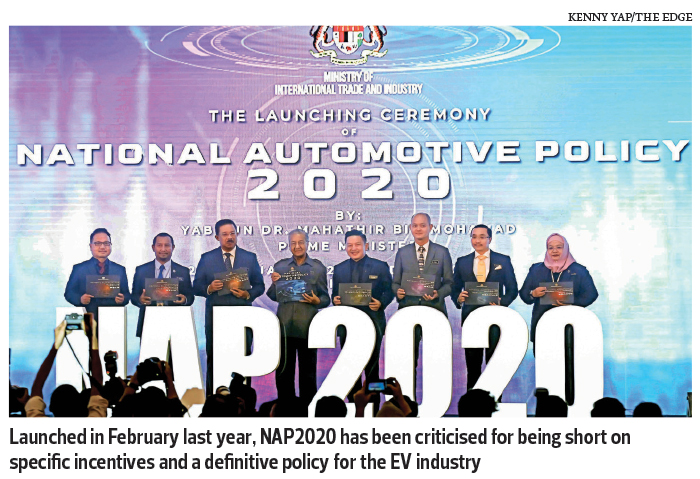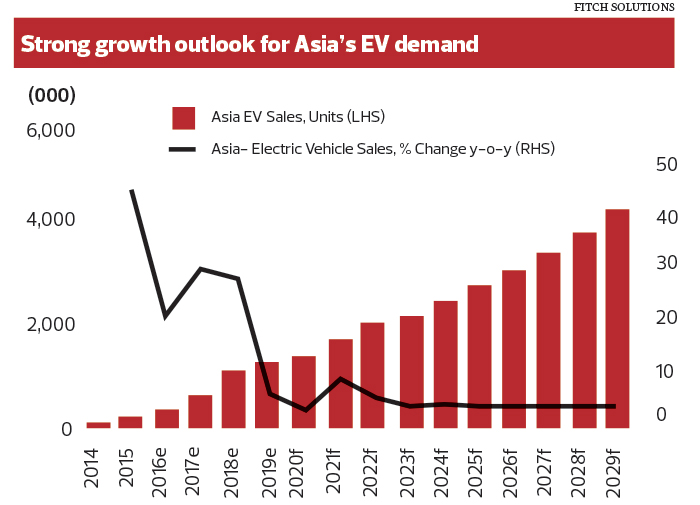I’M done with Malaysia. I am packing up and going to India and Indonesia to sell my technology to local bus manufacturers there,” says a Shah Alam-based developer of technology for electric bus powertrains.
His frustration is understandable, given that Malaysia has yet to provide any meaningful incentives for the development of the electric vehicle (EV) industry that would encourage adoption of the technology in the local market.
Since 2012, his company has sunk in about RM45 million to locally develop electric bus technology — an investment that it may not be able to recoup if it continues to bank on Malaysia to adopt the technology. Its investors and creditors are running out of patience.
Still tinkering with its EV policy, the country has been left behind by its regional competitors Thailand and Indonesia, which have been seeing huge investments from global technology companies that manufacture and assemble EVs and EV-related technologies such as lithium-ion batteries and energy storage systems (ESS). Is it a case of too little too late for Malaysia?
Foreign automotive investors have made it clear that what they desire are menu-based incentives, for two main reasons: first, this makes it easier for their principals to decide whether the incentives are worth their while and second, they know that their competitors will get the same incentives. It’s kind of like a level playing field where everyone knows what’s on the table.
However, under Putrajaya’s customised incentives — as previously proposed — the incentives are customised to particular investments, depending on the level of localisation, the vendor development programmes and even how much Malaysian workers will be paid. As such, the incentives would differ from one investment to the other, and foreign automakers are not in favour of this.
There are other sticking points as well. One is the current categorisation of EVs, which foreign automakers find confusing and lacking in clarity.
Despite the foot dragging, Putrajaya believes there is still time for Malaysia to catch up and is formulating a specific policy for the EV industry as part of the National Automotive Policy 2020 (NAP2020).
Datuk Madani Sahari, CEO of the Malaysia Automotive, Robotics and IoT Institute (MARii), tells The Edge that the government understands that EV is important for various reasons. “First, it is important from the environmental angle. Second, from the technology angle. If we do not go into EV, there will be many aspects of the technology that will not be deployed in our country. So, that will be a loss to Malaysia.”
Launched in February last year, NAP2020 has been criticised for being short on specific incentives and a definitive policy for the EV industry. Under the plan, EVs are bundled together with other types of powertrains that are more energy-efficient compared with traditional internal combustion engines (ICE), such as hybrids, and even ICE with energy-efficient features. These are called energy-efficient vehicles (EEVs).
They are also bundled together with ICE vehicles that have connectivity and autonomous features, called the Next Generation Vehicles (NxGVs). Given the lack of clarity over EVs, industry players are reluctant to commit investments in Malaysia.
At the same time, NAP2020 retains the customised incentives (CI) policy for automotive investments from the 2014 version, which industry players have already made known they do not like.
Many players — especially the foreign ones — say the incentives are too general. What they require are specific or menu-based incentives to present to their principals to decide whether to invest in Malaysia or elsewhere.
Madani insists that the government realises that NAP2020 must be improved to attract foreign direct investments (FDIs) to the EV industry and is listening to the players. With Indonesia and Thailand drawing large investments into the segment, Malaysia cannot stand still with the same policy.
“There has been a lot of engagement between the government and the OEMs (original equipment manufacturers). They want to bring in more investments in EV technology to Malaysia, but they require measures that are more robust and specific to EV,” he says. “And we listen; the government is not stubborn and saying that everything must be customised incentives. We have been listening to and engaging with the industry. They are asking whether the government can be more flexible for EVs and allow EVs to come in with measures that do not require so much calculation of ROIs (returns on investment) and customising.”
This suggests that simpler but more robust incentives be given to convince the big names in particular that Malaysia is a more favourable investment destination.
One area where NAP2020 has been refined is to allow foreign automakers to bring in a number of completely built-up (CBU) units based on the value of investments coming in, says Madani, explaining that there will be a conversion rate for the number of CBU units allowed to be brought in by foreign automakers at zero excise duty, and that this conversion rate will be fixed or menu-based.
Under the existing NAP2020, there is no direct conversion of how many CBU units can be brought in at zero excise duty. The number of CBU units that can be brought in this way under the current automotive policy is part of the CI regime, which comes with a calculation of ROIs for the government and automaker.
“The new policy will be broad-based, touching from the incentive standpoint, and infrastructure, consumer and further technology development to ensure that we are not left behind in starting and continuing our production of EVs,” says Madani.
“It also includes awareness of EVs among the people. We can produce so many EVs, but if the buyers do not realise the importance of EVs, it will render this whole thing useless. So, the new review will cover all those angles.”
Malaysia’s EV ecosystem needs clarity
In recent years, Indonesia and Thailand have clinched a number of investments from not only automakers but also EV battery makers.
On Nov 4 last year, Thailand’s Board of Investments (BOI) approved a THB3.2 billion (RM432 million) investment by Auto Alliance (Thailand) Co Ltd — a joint venture between Ford Motor Company and Mazda Motors Corp — to produce 5,000 plug-in hybrid electric vehicles (PHEVs) and 1,000 battery electric vehicles (BEVs) for the local market.
About a month later, Indonesia’s Deputy Minister at the Coordinating Ministry of Maritime and Investment Affairs Septian Hario Seto announced that China-based Contemporary Amperex Technology Co Ltd would be investing US$5 billion in a lithium battery plant in the republic.
Madani maintains that Malaysia already has a good ecosystem in the production of lithium batteries, which are used in the production of EVs. “Samsung SDI has a plant in Senawang, Negeri Sembilan, and it has been producing lithium-ion batteries for a few years. It has already started producing lithium cells meant for EVs,” he says, adding that there have been talks with Samsung SDI to immediately leverage its investments and to get its EV lithium batteries going to help enable Malaysia to be an EV production hub.
Materials needed for the manufacturing of lithium-ion batteries, such as the solutions and copper coils inside the batteries, are already being produced in the country.
However, the late revision to the EV policy may have dampened investor interest in Malaysia. Other countries, aware of the stiff competition for foreign investment, have made far greater headway as evidenced by their announcements of investments coming into the sector.
Critics say it is imperative for the government to quickly approve the EV policy drafted by MARii and other agencies as they are concerned that progress has been slow.
Although there was no specific policy for the EV industry in NAP2020, NanoMalaysia Bhd, an agency tasked with facilitating the commercialisation of R&D and industrialising nanotechnology in the country, has been working full-time to facilitate the adoption of nanotechnology in other industries. Its CEO Dr Rezal Khairi Ahmad believes that Malaysia should not focus too much on trying to get FDI into the EV industry by attracting major automakers to set up assembly lines here because even though the assembly plants will be churning out high-value products, the jobs created will still be low-paying.
Instead, Malaysia should develop technologies that will be part of the EV ecosystem. These technologies — designed, developed and produced by local companies and talents — will create more high-paying jobs than assembly plants, he points out.
“Indonesia is doing what we have been doing for the past 20, 30 years — just that it happens to be in EV. It will be beholden to the companies’ technologies; they are still beholden to or dependent on the external supply chain,” says Rezal.
“So Malaysia, having a much smaller market, will have to be in a different game. We cannot compete with what Indonesia is doing. We cannot present an immediate-term market for EVs as it is still a niche, probably like a T20 (top 20% income group) market, as opposed to the M40 and B40 (middle 40% and bottom 40% groups). We don’t have economies of scale.
“So, we must think differently to become a high-value EV economy by looking at the components, the parts. We design, develop and produce. We may not be able to address those in Malaysia, but we will be able to export to our neighbouring markets in Asean and beyond.”
Despite Malaysia’s lack of EV policy direction, NanoMalaysia continues to follow market forces to determine which kind of technology development should be given priority. “We decided to undertake technological development into some of the key components that will contribute to the EV industry, whether it is in the local, regional or global markets. We have voluntarily and proactively pursued that agenda ourselves, at our level, within our scope of control,” says Rezal.
“We have activated a number of projects. We are looking at battery technology, fuel cell technology, hydrogen technology, charging technology, autonomous vehicles and so on. Our role here is primarily as a subject-matter expert who understands what constitutes EVs from the ground up and what the main points are in terms of rolling out EVs in the market.”
Being a rather new technology, the development of an EV industry or ecosystem is akin to a chicken-or-egg kind of situation. Should EVs be on the road first or should the infrastructure supporting EVs, such as charging stations and service centres, be built first?
However, Rezal says the agency has managed to break the “vicious cycle of the chicken-or-egg question”. Among the technologies that NanoMalaysia has helped develop, together with other local technology companies, is Onboard Generated Hydrogen Fuel Cell — a type of power system that generates hydrogen from water, to be used as fuel on board a vehicle.
This technology will address the need for charging or fuelling infrastructure for EVs. However, the successful commercialisation of the technology in Malaysia will very much depend on what kind of EVs the government would like to promote.
Therefore, clarity on the policy is important for the EV industry to chart its investment plans. If the policy merely focuses on BEVs and PHEVs, there may be obstacles to the development and commercialisation of hydrogen fuel cell technology.
Can the EV market grow without subsidies?
It is widely accepted that the way forward in terms of transport is with EVs, as the world tries to reduce the impact of global warming. Cleaner technology is one of the steps towards reducing hydrocarbon consumption and high greenhouse gas emissions.
However, the prohibitive costs of owning an EV has stunted the industry’s growth, or at least caused it to develop not sufficiently quickly to have a meaningful impact on global warming. The sales of EVs only made up about 4.2% of global car sales in 2020.
Many governments around the world already subsidise the cost of owning an EV directly, in the sense that even after all the tax incentives provided to manufacturers, they also provide rebates on the cost of EV ownership. In Malaysia, for instance, electric scooters are priced at about RM17,000 per unit, which is way beyond the means of the typical scooter market, usually the B40 group.
However, China has taken a different approach. The Asian superpower is rolling back its subsidies programme for EVs at the national level. Beijing believes that the country’s EV industry should rely on innovation rather than government assistance as the industry matures and costs fall.
In April last year, China announced that it would cut subsidies for EVs by 10% in 2020, 20% in 2021 and 30% in 2022, and terminate it altogether in 2023. It is targeting EVs to make up about 20% of total vehicle sales by 2025 and 50% by 2035.
This target is unrealistic, says Fitch Solutions in a December 2020 report. With the absence of subsidies, the research firm forecasts that EVs will only account for about 10% of total domestic vehicle sales in 2025 and only 15% in 2029, far short of China’s targets.
Nevertheless, local governments in China are likely to continue offering subsidies for EVs, and this will ensure that the growth of EVs in the country remains robust, growing at 11.5% annually to reach a total industry volume of 3.8 million units by 2029, it adds.
Will Malaysia offer subsidies or rebates for EV ownership under the newly formulated policy? Given the situation of the government’s finances, this is unlikely, although the details remain to be seen.
MARii, for instance, has already been discussing with one of the early adopters of EVs in Malaysia to see how production costs can be reduced. According to Madani, it has engaged with e-scooter manufacturer Eclimo on how to lower the cost of its materials so that the end product will be more affordable to consumers.
At the moment, Eclimo only leases its ES-11 e-scooters to corporations and agencies that employ a large fleet of riders. On its website, it lists KFC Holdings (M) Bhd, the Penang and Melaka city councils and the Royal Malaysian Police as its partners.
The ES-11 uses lithium-ion batteries for power and has a maximum range of 100km per full charge. The battery has a life cycle of 1,000 charges, according to Eclimo’s website.
Madani says the government is considering more incentives for the company’s production and products in a bid to make the e-scooter more affordable.
As for the electric bus powertrain manufacturer whom The Edge spoke to, while he is ready to bring his technology to India and Indonesia, he is still hoping Malaysia will recognise his products one day.
Can Malaysia make up for lost time and catch up with its regional rivals in developing a sustainable and robust EV industry? The clock is ticking.
See also "EV theme takes centre stage" in Capital Page 32
http://www.theedgemarkets.com/article/cover-story-ev-race-can-malaysia-keep







